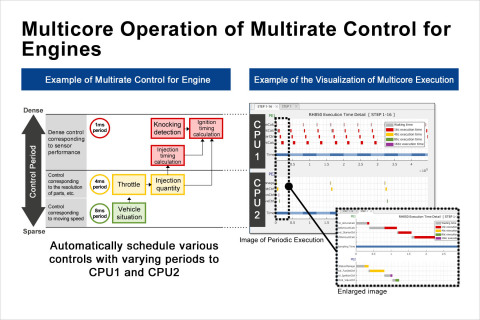RH850 Model-Based Development Environment Supports Development of Systems With Multirate Control (Multiple Control Periods)
MILPITAS, Calif. — (BUSINESS WIRE) — June 14, 2018 — Renesas Electronics Corporation (TSE: 6723), a premier supplier of advanced semiconductor solutions, today announced an update to its “Embedded Target for RH850 Multicore” model-based development environment for multicore microcontrollers (MCUs) for automotive control applications. The update supports development of systems with multirate control (multiple control periods), which is now common in systems such as engine and body control systems. This model-based development environment has become practical even in software development scenarios for multicore MCUs, and can reduce the increasingly complex software development burdens especially in control system development of self-driving cars.
This press release features multimedia. View the full release here: https://www.businesswire.com/news/home/20180614005297/en/

Multicore Operation of Multirate Control for Engines (Graphic: Business Wire)
Renesas’ earlier RH850 multicore model-based development environment automatically allocated software to the multiple cores and although verifying performance was possible, in complex systems that included multirate control, it was necessary to implement everything manually, including the RTOS and device drivers. Now, to meet the ever-increasing requirements for engine and vehicle performance, and at the same time shorten product development time, by making this development environment support multirate control, it is possible to directly generate the multicore software code from the multirate control model. This has made it possible to evaluate the execution performance in simulation. Not only does this allow execution performance to be estimated from the earliest stages of software development, this also makes it easy to feed back the verification results into the model itself. This enables the completeness of the system development to be improved early on in the process, and the burden of developing the ever-larger scale, and increasingly complex, software systems can be significantly reduced. Renesas is accelerating the practical utility of model-based development environments in software development for multicore processors and is leading the evolution of green electric vehicles as proposed in the Renesas autonomy™ concept.
Renesas will provide the "Embedded Target for RH850 Multicore" updated model-based development environment starting in the fall of 2018. In preparation for that release, Renesas will be presenting a demonstration of this development environment on Tuesday, July 3, 2018, at the MathWorks Automotive Conference 2018, to be held at the Tokyo Conference Center Shinagawa.
"Model-based development is becoming increasingly common, and Renesas has now completed an environment that covers from control design through automatic code generation. At the same time, since multicore software is complex, it was difficult to handle such software in earlier model-based development environments,” said Hiroyuki Kondo, Vice President of Shared R&D Division 1, Automotive Solution Business Unit, Renesas Electronics Corporation. “Leveraging our extensive expertise in automotive control use cases, we were able to start working on practical application of this technology early on, and thus succeeded in creating this update. I am confident that our model-based development environment will bring dramatically improved efficiency in software development for multicore microcontrollers."
Key features of the updated “Embedded Target for RH850 Multicore” model-based development environment
-
Support for multirate control significantly
reduces the burden of multicore software development
Control functions development requires multirate control, such as intake/exhaust period in engine control, the period of fuel injection and ignition, and the period with which the car's status is verified. These are all different periods. By applying the technology that generates RH850 multicore code from the Simulink® control mode to multirate control, it has become possible to directly generate multicore code, even from models that include multiple periods, such as engine control. Renesas also provides as an option for the Integrated Development Environment CS+ for the RH850, a cycle precision simulator that can measure time with a precision on par with that of actual systems. By using this option, it is possible to estimate the execution performance of a model of the multicore MCU at the early stages of software development. This can significantly reduce the software development period.
-
Conforms to the de-facto standard JMAAB
control modeling guidelines for automotive model-based development
The JMAAB (Japan MBD Automotive Advisory Board), an organization that promotes model-based development for automotive control systems, recommends several control models from the JMAAB Control Modeling Guidelines. Of those, Renesas is providing in this update the Simulink® Scheduler Block, which conforms to type (alpha), which provides a scheduler layer in the upper layer. This makes it possible to follow the multirate single-task method without an OS, express the core specifications and synchronization in the Simulink® model, and automatically generate multicore code for the RH850 to implement deterministic operations.
-
Overall operational verification of an ECU
that integrates multiple systems is also possible
Along with advances in the degree of electronic control in today's cars, integration is also progressing in the ECUs (electronic control units), which are comparatively small-scale systems. By supporting multirate control, making it easier to operate small-scale systems with different control periods with a multicore microcontroller, it is now possible to verify the operation of a whole ECU that integrates multiple systems.








